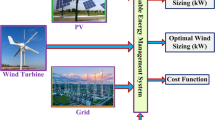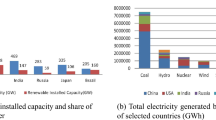Abstract
Optimal power flow (OPF) is one of the most fundamental single/multi-objective, nonlinear, and non-convex optimization problems in modern power systems. Renewable energy sources are integrated into power systems to provide environmental sustainability and to reduce emissions and fuel costs. Therefore, some conventional thermal generators are being replaced with wind power sources. Although wind power is a widely used renewable energy source, it is intermittent in nature and wind speed is uncertain at any given time. For this reason, the Weibull probability density function is one of the important methods used in calculating available wind power. This paper presents an improved method based on the Lévy Coyote optimization algorithm (LCOA) for solving the OPF problem with stochastic wind power. In the proposed LCOA, Lévy Flights were added to the Coyote optimization algorithm to avoid local optima and to improve the ability to focus on optimal solutions. To show the effect of the novel contribution to the algorithm, the LCOA method was tested using the Congress on Evolutionary Computation-2005 benchmark test functions. Subsequently, the solution to the OPF problem with stochastic wind power was tested via the LCOA and other heuristic optimization algorithms in IEEE 30-bus, 57-bus, and 118-bus test systems. Eighteen different cases were executed including fuel cost, emissions, active power loss, voltage profile, and voltage stability, in single- and multi-objective optimization. The results showed that the LCOA was more effective than the other optimization methods at reaching an optimal solution to the OPF problem with stochastic wind power.



Similar content being viewed by others
References
Duman S, Güvenç U, Sönmez Y, Yörükeren N (2012) Optimal power flow using gravitational search algorithm. Energy Convers Manag 59:86–95
Sönmez Y, Güvenc U, Duman S, Yörükeren N (2012) Optimal power flow incorporating FACTS devices using gravitational search algorithm. In: 2012 international symposium on innovations in intelligent systems and applications (INISTA), pp 1–5, IEEE
He S, Wen JY, Prempain E, Wu QH, Fitch J, Mann S (2004) An improved particle swarm optimization for optimal power flow. In: International conference on power system technology (POWERCON), Singapore, pp 1633–1637
Abido MA (2002a) Optimal power flow using tabu search algorithm. Electr Power Compon Syst 30(5):469–483
Glover JD, Sarma MS (2002) Power system analysis and design, 3rd edn. Brooks/Cole, New York, pp 275–276
Yan X, Quintana VH (1999) Improving an interior-point-based off by dynamic adjustments of step sizes and tolerances. IEEE Trans Power Syst 14(2):709–716
Olofsson M, Andersson G, Söder L (1995) Linear programming based optimal power flow using second order sensitivities. IEEE Trans Power Syst 10(3):1691–1697
Sun DI, Ashley B, Brewer B, Hughes A (1984) Optimal power flow by newton approach. IEEE Trans Power Appar Syst 3(10):2864–2880
Santos A, Deckmann S, Soares S (1988) A dual augmented Lagrangian approach for optimal power flow. IEEE Trans Power Syst 3(3):1020–1025
Osman MS, Abo-Sinna MA, Mousa AA (2004) A solution to the optimal power flow using genetic algorithm. Appl Math Comput 155(2):391–405
A. Bhattacharya and P.K. Roy “Solution of multi-objective optimal power flow using gravitational search algorithm,” IET Generation, Transmission, Distribution vol.6, no.8, pp.751–763,2012
Roy PK, Paul C (2015) Optimal power flow using krill herd algorithm. Int Trans Electr Energy Syst 25(8):1397–1419
Abido MA (2002b) Optimal power flow using particle swarm optimization. Int J Electr Power Energy Syst 24(7):563–571
Mohamed A-AA, Mohamed YS, El-Gaafary AAM, Hemeida AM (2017) Optimal power flow using moth swarm algorithm. Electr Power Syst Res 142:190–206
El Ela AAA, Abido MA, Spea SR (2010) Optimal power flow using differential evolution algorithm. Electr Power Syst Res 80(7):878–885
Mahdad B, Srairi K (2015) Blackout risk prevention in a smart grid based flexible optimal strategy using Grey Wolf-pattern search algorithms. Energy Convers Manag 98:411–429
Manoranjitham GE, Shunmugalatha A (2015) Application of firefly algorithm on optimal power flow control incorporating simplified impedance UPFC model. Int J Electr Power Energy Syst 71:358–363
El-Fergany A, Hasanien HM (2019) Salp swarm optimizer to solve optimal power flow comprising voltage stability analysis. Neural Comput Appl. https://doi.org/10.1007/s00521-019-04029-8.Inpress
Roa-Sepulveda CA, Pavez-Lazo BJ (2003) A solution to the optimal power flow using simulated annealing. Int J Electr Power Energy Syst 25(1):47–57
Bouktir T, Slimani L, Belkacemi M (2004) A genetic algorithm for solving the optimal power flow problem. Leonardo J Sci 4(4):44–58
Dutta P, Sinha AK (2006) Voltage stability constrained multi-objective optimal powerflow using particle swarm optimization. In: First international conference on industrial and information systems (ICIISs), Sri Lanka, pp 161–166
Mukherjee A, Mukherjee V (2015) Solution of optimal power flow using chaotic krill herd algorithm. Chaos Solitons Fract 78:10–21
Reddy SS, Rathnam CS (2016) Optimal power flow using glowworm swarm optimization. Int J Electr Power Energy Syst 80:128–139
Panda A, Tripathy M (2015) Security constrained optimal power flow solution of wind-thermal generation system using modified bacteria foraging algorithm. Energy 93:816–827
Marley JF, Vrakopoulou M, Hiskens IA (2016) An AC-QP optimal power flow algorithm considering wind forecast uncertainty. In: Innovative smart grid technologies-Asia (ISGT-Asia), Melbourne, Australia, pp 317–323
Reddy SS, Bijwe PR (2016) Day-ahead and real time optimal power flow considering renewable energy resources. Int J Electr Power Energy Syst 82:400–408
Roy R, Jadhav HT (2015) Optimal power flow solution of power system incorporating stochastic wind power using Gbest guided artificial bee colony algorithm. Int J Electr Power Energy Syst 64:562–578
Duman S (2019) Optimal power flow of power systems with controllable wind-photovoltaic energy systems via differential evolutionary particle swarm optimization. Int Trans Electr Energy Syst. https://doi.org/10.1002/2050-7038.12270
Hetzer J, Yu DC, Bhattarai K (2008) An economic dispatch model ıncorporating wind power. IEEE Trans Energy Convers 23(2):603–611
Reddy SS (2017) Optimal power flow with renewable energy resources including storage. Electr Eng 99(2):685–695
Biswas PP, Suganthan PN, Amaratunga GAJ (2017) Optimal power flow solutions incorporating stochastic wind and solar power. Energy Convers Manag 148:1194–1207
Duman S (2018) A modified moth swarm algorithm based on an arithmetic crossover for constrained optimization and optimal power flow problems. IEEE Access 6:45394–45416
Pierazan J, Coelho LDS (2018) Coyote optimization algorithm: a new metaheuristic for global optimization problems. In: IEEE congress on evolutionary computation (CEC), pp 1–8
Güvenc U, Kaymaz E (2019) Economic dispatch integrated wind power using Coyote optimization algorithm. In: Proceedings of the 2019 7th international Istanbul smart grids and cities congress and fair (ICSG), Istanbul, Turkey, pp 179–183, 25–26 April 2019
Yang X, Deb S (2013) Multi-objective cuckoo search for design optimization. Comput Oper Res 40:1616–1624
Yang XS (2010) Firefly algorithm, Levy flights and global optimization. Research and development in intelligent systems XXVI. Springer, London, pp 209–218
Candela R, Cottone G, Scimemi GF, Sanseverino ER (2009) Lévy flights for ant colony optimization in continuous domains. In: Mathematical theory and computational practice fifth conference on computability in Europe, Heidelberg, Germany, pp 79–88
Candela R, Cottone G, Scimemi GF, Sanseverino ER (2010) Composite laminates buckling optimization through Lévy based ant colony optimization. In: 23rd international conference on industrial engineering and other applications of applied intelligent systems, Cordoba, Spain, pp 288–297
Cottone G, Pirrotta A, Scimemi GF, Sanseverino ER (2010) Damage identification by Lévy ant colony optimization. In: Straub D (ed) Reliability and optimization of structural system. Taylor & Francis, London, pp 37–44
Zhang Y, Jin Z, Zhao X, Yang Q (2020) Backtracking search algorithm with Lévy flight for estimating parameters of photovoltaic models. Energy Convers Manag 208:112615
Suganthan PN, Hansen N, Liang JJ, Deb K, Chen Y-P, Auger A, Tiwari S (2005) Problem definitions and evaluation criteria for the CEC 2005 special session on real-parameter optimization, May 2005
Morshed MJ, Asgharpour A (2014) A hybrid imperialist competitive-sequential quadratic programming (HIC-SQP) algorithm for solving economic load dispatch with incorporating stochastic wind power: a comparative study on heuristic optimization techniques. Energy Convers Manag (Elsevier) 84:30–40
Liu X, Xu W (2010) Minimum emission dispatch constrained by stochastic wind power availability and cost. IEEE Trans Power Syst 25(3):1705–1713
Güvenç U, Duman S, Kaymaz E (2018) Economic dispatch of power system including wind power using salp swarm algorithm. Presented at 7th international conference on advanced technologies (ICAT'18), Antalya, Turkey
Kessel P, Glavitsch H (1986) Estimating the voltage stability of a power system. IEEE Trans Power Deliv 1(3):346–354
Barthelemy P, Bertolotti J, Wiersma DS (2008) A Lévy flight for light. Nature 453:495–498
Mantegna RN, Stanley HE (1994) Stochastic process with ultraslow convergence to a Gaussian: the truncated Lévy flight. Phys Rev Lett 73(22):2946
Yu JT, Kim CH, Wadood A, Khurshiad T, Rhee S (2019) Self-adaptive multi-population JAYA algorithm with Lévy flights for solving economic load dispatch problems. IEEE Access 7:21372–21384
Biedenkapp A, Lindauer MT, Eggensperger K, Hutter F, Fawcett C, Hoos HH (2017) Efficient parameter importance analysis via ablation with surrogates. In: AAAI, pp 773–779
Fawcett C, Hoos H (2016) Analysing differences between algorithm configurations through ablation. Journal of Heuristics 22(4):431–458
Zhang X, Zhang X (2020) Aset-based differential evolution algorithm for QoS-oriented and cost-effective ride sharing. Appl Soft Comput J 96:1–11
Zheng W, Gou C, Yan L, Wang F-Y (2019) Differential-evolution based generative adversarial networks for edge detection. In: CVPR workshops
Li L, Wei Z, Hao J-K, He K (2020) Probability learning based tabu search for the budgeted maximum coverage problem. arXiv:2007.05971 [cs.AI]
2019 Formula One World Championship Scoring System. https://en.wikipedia.org/wiki/2019_Formula_One_World_Championship#Scoring_system
Alsac O, Stott B (1974) Optimal load flow with steady-state security. IEEE Trans Power Appar Syst 93(3):745–751
Zimmerman RD, Murillo-Sánchez CE, Thomas RJ (2018) Matpower. https://www.pserc.cornell.edu/matpower/. Accessed 31 Oct 2018
Hınıslıoğlu Y (2018) Kaotik güve sürüsü algoritması kullanarak rüzgar gücü entegreli optimal güç akışı. M.Sc. thesis, Department of Electrics & Electronics and Computer Engineering, Duzce University, Duzce, Türkiye
Author information
Authors and Affiliations
Corresponding author
Ethics declarations
Conflict of interest
The authors declare that they have no conflict of interest.
Additional information
Publisher's Note
Springer Nature remains neutral with regard to jurisdictional claims in published maps and institutional affiliations.
Rights and permissions
About this article
Cite this article
Kaymaz, E., Duman, S. & Guvenc, U. Optimal power flow solution with stochastic wind power using the Lévy coyote optimization algorithm. Neural Comput & Applic 33, 6775–6804 (2021). https://doi.org/10.1007/s00521-020-05455-9
Received:
Accepted:
Published:
Issue Date:
DOI: https://doi.org/10.1007/s00521-020-05455-9




